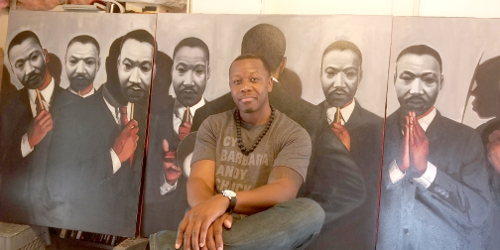
Tylonn J. Sawyer, a figurative artist, creates powerful images on canvas. They depict the struggles of humanity and the fragility of human nature, and they come from a distinct point of view.
"My style has evolved but my work is really always focused on the world from a black perspective, no matter what the particular topic I am talking about," Sawyer, 40, explained.
A Detroit native, Sawyer grew up in an artistic family.
"I've been drawing my whole life," he said. "Even though my parents didn't necessarily go into art, I constantly had it around me."
Sawyer began college at Eastern Michigan University where he studied computer-aided art, which lacked the creative aspect of art. He took a couple drawing classes as a freshman and received A's.
"I was kind of hooked after that. I started to understand that it was possible to make a living out of doing this and not just have to be a starving artist in the studio," he said.
Sawyer went on to earn a master's degree from the New York Academy of Art Graduate School of Figurative Art. But while learning the history and mechanics of figurative art he was always disappointed by the lack of black faces in the works he was asked to study and, indeed, of the faces of the artists whose works he was studying.
"For my thesis project I did a huge slave ship painting and portrayed people in the slave ship compartments and used slavery as a metaphor for self-imposed problems and how you can box yourself in," said Sawyer, who won a trip to study at the Royal Academy of Art in London.
Here in Detroit, Sawyer has earned a reputation not only as a gifted artist but also as a stern instructor. He is an associate professor at Oakland Community College and also teaches at the College for Creative Studies from time to time.
"I have a specific skill set and I really enjoy sharing it," he said. "I think it's important intergenerationally to kind of share certain art forms and pass them down so tradition isn't lost. But at the same time you can nurture new experiences that way…I really love teaching. To see somebody at the beginning of the semester who is struggling and not doing well. Then at the end of the semester when you show them a whole breadth of their work and they can see the improvement. You almost can't tell it's the same person. That's the amazing part as an instructor. I don't think I'm a tough instructor. I think I'm demanding."
Though in his early days teaching Sawyer admits to doing a bit of a drill sergeant imitation, mimicking some of his own college instructors. With time he said he came around.
"Now I really try to come at it from a place of love and understanding," said Sawyer. "I nurture what they do and when they do something really well I talk about that and inspire them to do more of that. And when something's not working I just offer advice as to what can make it stronger rather than just saying this looks bad."
In his own pieces, Sawyer knows what works. About two years ago, he started incorporating masks, or people holding masks in front of their faces, in his art.
"I was thinking about how in certain African cultures they used masks as a way to evoke the spirit of their ancestors," he said. "Or like in orphic types of religion, there's a crocodile tribe that has a big crocodile mask that they put on and they try to evoke the spirit of the crocodile because they worship this crocodile in the river. So I was thinking about in contemporary times, what if people wore these kind of makeshift masks to do a similar thing and evoke the spirits of our past archetypes like Martin Luther King, Nina Simone, James Baldwin? And in that way see if we can somehow get a little bit of the spirit of what they had in that particular time. Each one is a little different but that's the starting part of them."
In this current political climate, Sawyer sees inspiration everywhere.
"Especially since the election I'm thinking about the relationship of people of color to the United States and even now, we see in the news people wanting to tear down idols and tear down monuments. You see them focusing in on this narrow thing. But you can't be that specific about it. Because if you really want to talk about racism in terms of the imagery of the relationship of the United States we would have nothing up. We wouldn't have any images on money because this country to me is sort of a monument to that kind of oppression. And not just necessarily to black people but to poor people, to women. This is the world. And not just the United States. I can't really think of a place on earth that would be exempt to that kind of indictment."
If Sawyer's vision seems radical he has no problem with that. At a bare minimum he hopes his work is thought provoking.
"Figurative art in and of itself is visceral so when people look at it, it's challenging for them to go beyond just exactly what they're seeing even if it does have a different meaning to it. So I like to make the image where it's something you can recognize but it's still a kind of visual poetry where you're going to look at it and be like why? If the first question is why are these people wearing masks then that's a great start. Then it's up to you."
Sawyer said he can discuss his work in-depth, but he'd much rather his audience interrogate the piece themselves and come up with their own explanation.
"If they're really, really far off, I'll correct people and be like no, it's nothing like that at all. But at least I know that I've succeeded in kind of creating that type of poetry which causes people to have to engage with the work themselves and have to figure some things out."
Artist, Teacher Makes Black Faces Valid in Art











